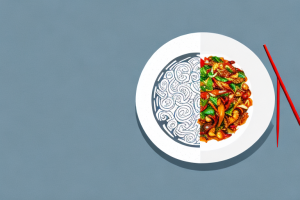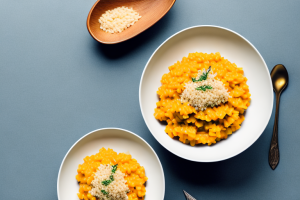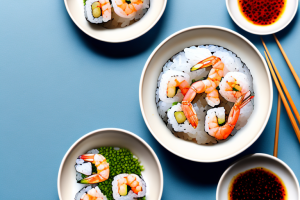How to prepare basmati rice with shrimp
9 min read
A bowl of steaming basmati rice with shrimp on top
If you’re looking for a healthy and delicious meal that’s easy to make, look no further than basmati rice with shrimp. Not only is this dish packed with flavor, but it’s also highly nutritious. In this article, we’ll take a closer look at what basmati rice is, the health benefits of eating it with shrimp, and provide you with a step-by-step guide on how to prepare this dish at home.
What is basmati rice?
Basmati rice is a type of long-grain rice that originated in the Indian subcontinent. This rice is highly aromatic, and its flavor is often described as nutty and slightly floral. Basmati rice is commonly used in Indian, Middle Eastern, and South Asian cuisines.
Basmati rice is also known for its unique cooking properties. When cooked, the grains remain separate and fluffy, making it a popular choice for biryanis, pilafs, and other rice dishes. Additionally, basmati rice is considered to be a healthier option compared to other types of rice, as it has a lower glycemic index and is rich in essential nutrients such as vitamins and minerals.
What are the health benefits of eating basmati rice and shrimp?
Basmati rice and shrimp are both highly nutritious foods. Basmati rice is a good source of fiber, B vitamins, and essential minerals, such as magnesium and potassium. Shrimp is an excellent source of protein, and it’s also low in calories and fat. Additionally, shrimp are rich in omega-3 fatty acids, which have been shown to have numerous health benefits, including reducing inflammation and lowering the risk of heart disease.
Furthermore, basmati rice has a low glycemic index, which means it can help regulate blood sugar levels and prevent spikes in insulin. This makes it a great option for people with diabetes or those looking to manage their blood sugar levels.
When combined with shrimp, basmati rice can provide a well-rounded meal that is not only delicious but also beneficial for your health. Shrimp contains antioxidants that can help protect your cells from damage and boost your immune system. It also contains selenium, which is important for thyroid function and can help reduce the risk of certain types of cancer.
How to clean and devein shrimp
Cleaning and deveining shrimp is an important step in preparing this dish. To clean shrimp, start by removing the head and shell. Then, use a sharp knife or kitchen scissors to make a shallow cut along the back of the shrimp. Use your fingers or a small knife to remove the vein that runs along the back of the shrimp. Rinse the shrimp under cold water and pat it dry with a paper towel.
It is important to note that not all shrimp need to be deveined. Shrimp that are smaller in size, such as salad shrimp, typically do not have a visible vein and do not need to be deveined. However, larger shrimp, such as jumbo or tiger shrimp, often have a visible vein and should be deveined to ensure the best taste and texture. Always check the packaging or ask your fishmonger if you are unsure whether or not your shrimp needs to be deveined.
How to choose the best quality basmati rice
When it comes to choosing the best quality basmati rice, look for rice that is long-grained, slender, and aromatic. It’s also a good idea to opt for organic and non-GMO rice, as these varieties are often higher in nutritional value and free from harmful chemicals. The packaging of the rice should also be checked for any signs of damage or insects.
Another important factor to consider when choosing basmati rice is the age of the rice. Freshly harvested rice is often considered to be of higher quality, as it retains more of its natural flavor and aroma. Look for rice that has been harvested within the last year for the best quality.
Additionally, the region where the rice is grown can also impact its quality. Basmati rice grown in the foothills of the Himalayas is often considered to be the best, as the soil and climate in this region are ideal for growing high-quality rice. Be sure to check the packaging or ask the seller about the origin of the rice before making your purchase.
The right ratio of water to basmati rice for perfect cooking
The key to perfectly cooked basmati rice is the ratio of water to rice. For every cup of basmati rice, add 1 1/2 cups of water. Place the rice and water in a pot, cover it with a tight-fitting lid, and bring it to a boil over medium-high heat. Once the water is boiling, reduce the heat to low and let the rice simmer until all the liquid is absorbed, usually around 20 minutes.
It’s important to note that the quality of the rice and the altitude at which you are cooking can also affect the cooking time and water ratio. If you are cooking at a high altitude, you may need to add more water and increase the cooking time. Additionally, if you are using older rice, it may require more water to fully cook.
For added flavor, you can also try cooking the rice in chicken or vegetable broth instead of water. This will give the rice a richer taste and can be a great option for dishes like pilaf or biryani.
Best cooking methods for basmati rice with shrimp
There are several cooking methods that can be used to prepare basmati rice with shrimp. One popular method is to sauté the shrimp with garlic and ginger, and then add it to the cooked basmati rice. Another approach is to cook the shrimp and rice separately, and then mix them together with additional seasonings and spices. Regardless of the method, it’s important to follow the appropriate cooking instructions to ensure that the dish is cooked to perfection.
Another cooking method that can be used for basmati rice with shrimp is to bake it in the oven. This method involves cooking the rice and shrimp together in a casserole dish with broth, vegetables, and spices. The dish is then covered and baked in the oven until the rice is tender and the shrimp is cooked through.
For those who prefer a healthier option, steaming the basmati rice and shrimp is a great choice. This method involves cooking the rice and shrimp in a steamer basket over boiling water. The dish can be seasoned with herbs and spices, and served with a side of steamed vegetables for a complete meal.
Tips to achieve perfectly cooked and fluffy basmati rice
To achieve perfectly cooked and fluffy basmati rice, make sure to rinse the rice thoroughly before cooking it. Also, let the rice rest for several minutes after it’s done cooking, and fluff it up with a fork to release any steam. Additionally, avoid lifting the lid while the rice is cooking, as this can affect the cooking time and moisture levels in the pot.
Another important tip to keep in mind is to use the right amount of water when cooking basmati rice. The general rule of thumb is to use 1.5 to 2 cups of water for every cup of rice. However, this can vary depending on the age and quality of the rice, so it’s always a good idea to check the package instructions or do a quick online search for the recommended water-to-rice ratio.
Lastly, consider adding some flavor to your basmati rice by cooking it with spices, herbs, or broth instead of plain water. You can also mix in some vegetables or nuts for added texture and nutrition. Experiment with different flavor combinations to find your favorite way to enjoy perfectly cooked and fluffy basmati rice.
How to season your basmati rice and shrimp for maximum flavor
Seasoning is key to adding maximum flavor to your basmati rice and shrimp dish. Common seasonings include salt, pepper, cumin, coriander, and turmeric. You can also add fresh herbs, such as cilantro or parsley, to enhance the dish’s overall flavor profile.
Another way to add flavor to your basmati rice and shrimp dish is by using aromatics like garlic, ginger, and onion. Sauté them in oil before adding the rice and shrimp to the pan. This will infuse the dish with a rich, savory flavor. Additionally, you can add a splash of lemon or lime juice to brighten up the dish and balance out the flavors. Experiment with different combinations of seasonings and aromatics to find the perfect flavor profile for your taste buds.
Garnish ideas to make your dish look Instagram-worthy
To make your basmati rice and shrimp dish look Instagram-worthy, consider adding colorful garnishes, such as sliced avocado or chopped tomatoes. You can also sprinkle chopped nuts, such as almonds or cashews, on top of the dish for some added texture and crunch.
Another great garnish idea for your dish is to add some fresh herbs, such as cilantro or parsley, on top. This will not only add a pop of color but also enhance the flavor of the dish. Additionally, you can add a drizzle of balsamic glaze or a squeeze of lemon juice to give the dish a tangy and zesty taste.
If you want to take your garnish game to the next level, try using edible flowers, such as pansies or nasturtiums, to decorate your dish. These flowers not only look beautiful but also add a unique flavor to the dish. Just make sure to use only edible flowers and avoid any toxic ones.
Sides that pair well with basmati rice and shrimp
There are many sides that pair well with basmati rice and shrimp. Some popular options include roasted vegetables, such as asparagus or broccoli, or a simple green salad with a tangy vinaigrette. You could also serve the dish with some warm naan bread or crispy pappadum crackers on the side.
How to store leftover basmati rice and shrimp for extended freshness
If you have any leftover basmati rice and shrimp, it’s important to store it properly to ensure it stays fresh for as long as possible. Place the leftovers in an airtight container and store it in the refrigerator for up to three to four days.
How to reheat leftover basmati rice and shrimp
To reheat leftover basmati rice and shrimp, place it in a microwave-safe container and microwave it for one to two minutes. Alternatively, you can heat it up in a skillet on medium-high heat for a few minutes until it’s heated through.
Variations of the recipe: how to make it vegan, vegetarian, or with other seafood
If you prefer to make this dish vegan or vegetarian, simply omit the shrimp and replace it with your favorite plant-based protein, such as tofu or chickpeas. You can also swap out the shrimp for other types of seafood, such as scallops or mussels. The recipe can be customized to suit your dietary preferences and tastes.
Frequently asked questions about cooking basmati rice with shrimp
Q: Can I use brown rice instead of basmati rice in this recipe?
A: Yes, you can use brown rice instead of basmati rice, but be aware that the cooking time and water ratio may differ.
Q: Can I substitute shrimp with chicken or beef in this recipe?
A: Yes, you can substitute shrimp with chicken or beef, but the cooking time and seasonings may need to be adjusted accordingly.
Q: Can I make this dish ahead of time?
A: Yes, you can make this dish ahead of time and store it in the refrigerator for up to four days. Reheat it before serving.
In conclusion, preparing basmati rice with shrimp is a great way to enjoy a healthy and delicious meal that’s easy to make. By following the tips and techniques outlined in this article, you can achieve perfectly cooked rice and succulent shrimp every time. Get creative with your seasonings and garnishes, and enjoy this flavorful dish with your favorite sides and companions.


